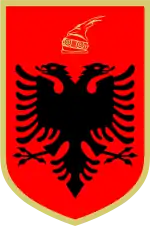Albanian Ohrid Lake Coast
The Albanian Ohrid Lake Coast (Albanian pronunciation: [brɛˈɡdɛ:ti ohˈrit] — Albanian: Bregdeti Ohrit) is a coastline of the Western Ohrid Lake, that encompasses the southeastern border of the Republic of Albania, stretching from the north of the Bay of Lin nearby the northern border shared with the Republic of Macedonia, across the villages of Memëlisht, Buqezë, Piskupat and the city of Pogradec, to the southern border shared with Macedonia as well.
| Albanian Ohrid Lake Coast | |
|---|---|
 Panoramic view above the village of Lin and Ohrid Lake in the background. | |
 Albanian Ohrid Lake Coast | |
| Location | Albania in Southern Europe |
| Coordinates | 40°59′N 20°38′E |
| Max. length | 31.51 kilometres (19.58 mi) |
| Settlements | Pogradec, Lin |
Albania is located in Southern and Southeastern Europe in the western section of the Balkan Peninsula. It borders on Montenegro to the northwest, Kosovo to the northeast, Macedonia to the east, Greece to the south and the Mediterranean Sea to the west. The coastline along the lake has a total length of 32 kilometres (20 mi) and specifically marked by a mountainous landscape supplied with small bays, sandy coasts and a unique marine life.
The Ohrid Lake is a deep, oligotrophic lake of tectonic origin in Southeastern Europe shared between Albania and the Republic of Macedonia. Approximately two thirds of the lake surface area belong to Macedonia and the remaining third to Albania. It is one of the most ancient lakes in the entire world and the largest in the Balkan Peninsula.[1][2] Despite the long and continuous history as well as the geographical isolation, it is the lake with the highest biodiversity in the world.[3]
The Ohrid-Prespa Transboundary Reserve is included in the World Network of Biosphere Reserves under the UNESCO Man and Biosphere Programme.[4] Most of the country's section of the lake is protected and designated as a protected landscape established on 18 February 1999.[5][6] The Natural and Cultural Heritage of the Ohrid Region is further included on the tentative list of Albania for designation as a UNESCO World Heritage Site.[7]
The region provides habitat for numerous threatened and endangered mammals, with at least twenty one native species recorded in the region.[2] This group includes the wolf, wildcat, otter, brown bear, and chamois. Classified as an Important Bird Area, it contains a wide range of bird habitats associated to topography and the types of vegetation communities of the region.[8] There are at least 137 bird species known to occur in the region with the most important species being the great white pelican, peregrine falcon, and eurasian coot.[2]
See also
References
- "Natural and Cultural Heritage of the Ohrid region". whc.unesco.org. pp. UNESCO.
- UNESCO, IUCN and Ministria e Mjedisit e Shqipërisë (January 2016). "TOWARDS STRENGTHENED GOVERNANCE OF THE SHARED TRANSBOUNDARY NATURAL AND CULTURAL HERITAGE OF THE LAKE OHRID REGION - Baseline Assessment of the Lake Ohrid region - Albania" (PDF). whc.unesco.org. pp. 1–126.
- IUCN. "TOWARDS STRENGTHENED GOVERNANCE OF THE SHARED TRANSBOUNDARY NATURAL AND CULTURAL HERITAGE OF THE LAKE OHRID REGION - Management Planning Expert" (PDF). iucn.org. pp. 1–3.
- UNESCO. "Ohrid-Prespa". unesco.org.
- Ministria e Mjedisit e Shqipërisë. "RRJETI I ZONAVE TË MBROJTURA NË SHQIPËRI" (PDF). cbd.int (in Albanian). Tirana. pp. 1–3.
- Ministria e Mjedisit e Shqipërisë. "FIFTH NATIONAL REPORT OF ALBANIA TO THE UNITED NATIONS CONVENTION ON BIOLOGICAL DIVERSITY (CBD)" (PDF). cbd.int. p. 45.
- "Natural and Cultural Heritage of the Ohrid Region". UNESCO World Heritage Site. Retrieved 6 July 2013.
- BirdLife International. "Lake Ohrid and surrounding area". datazone.birdlife.org.
